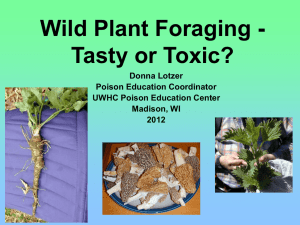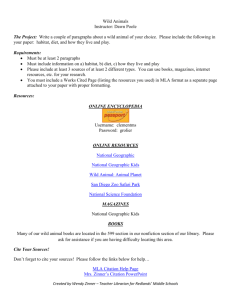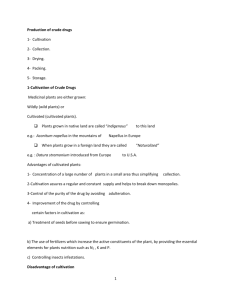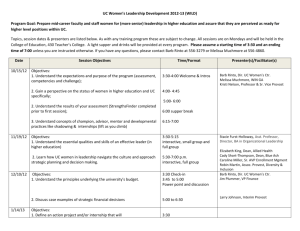Some Tips for the Wild Foods Forager
advertisement
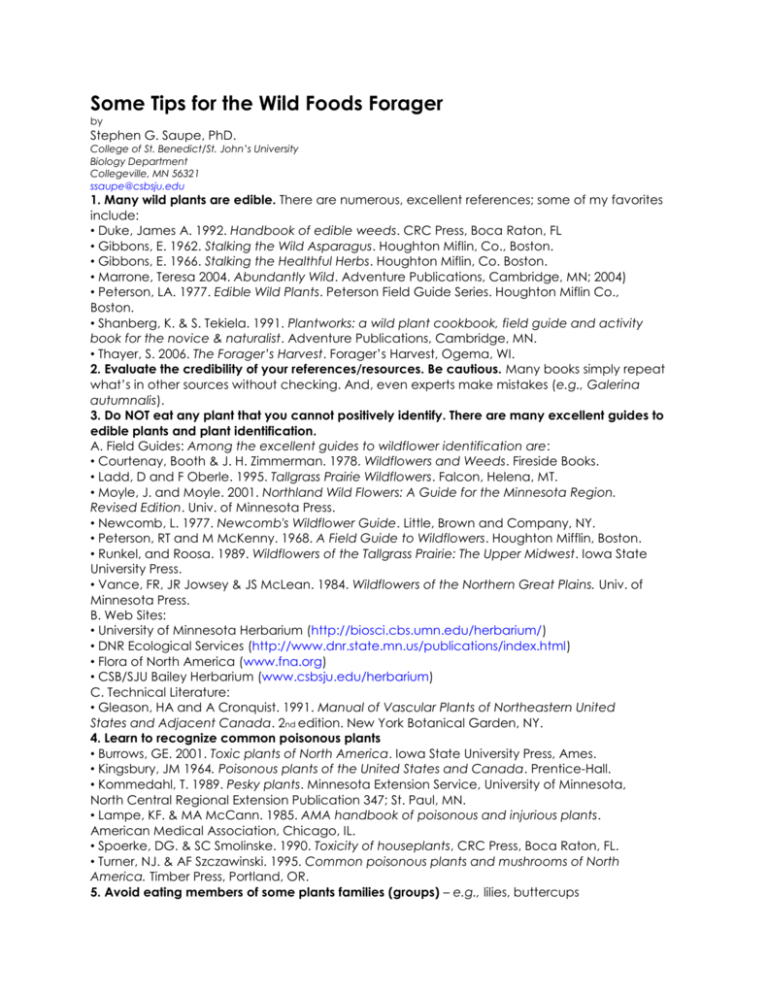
Some Tips for the Wild Foods Forager by Stephen G. Saupe, PhD. College of St. Benedict/St. John’s University Biology Department Collegeville, MN 56321 ssaupe@csbsju.edu 1. Many wild plants are edible. There are numerous, excellent references; some of my favorites include: • Duke, James A. 1992. Handbook of edible weeds. CRC Press, Boca Raton, FL • Gibbons, E. 1962. Stalking the Wild Asparagus. Houghton Miflin, Co., Boston. • Gibbons, E. 1966. Stalking the Healthful Herbs. Houghton Miflin, Co. Boston. • Marrone, Teresa 2004. Abundantly Wild. Adventure Publications, Cambridge, MN; 2004) • Peterson, LA. 1977. Edible Wild Plants. Peterson Field Guide Series. Houghton Miflin Co., Boston. • Shanberg, K. & S. Tekiela. 1991. Plantworks: a wild plant cookbook, field guide and activity book for the novice & naturalist. Adventure Publications, Cambridge, MN. • Thayer, S. 2006. The Forager’s Harvest. Forager’s Harvest, Ogema, WI. 2. Evaluate the credibility of your references/resources. Be cautious. Many books simply repeat what’s in other sources without checking. And, even experts make mistakes (e.g., Galerina autumnalis). 3. Do NOT eat any plant that you cannot positively identify. There are many excellent guides to edible plants and plant identification. A. Field Guides: Among the excellent guides to wildflower identification are: • Courtenay, Booth & J. H. Zimmerman. 1978. Wildflowers and Weeds. Fireside Books. • Ladd, D and F Oberle. 1995. Tallgrass Prairie Wildflowers. Falcon, Helena, MT. • Moyle, J. and Moyle. 2001. Northland Wild Flowers: A Guide for the Minnesota Region. Revised Edition. Univ. of Minnesota Press. • Newcomb, L. 1977. Newcomb's Wildflower Guide. Little, Brown and Company, NY. • Peterson, RT and M McKenny. 1968. A Field Guide to Wildflowers. Houghton Mifflin, Boston. • Runkel, and Roosa. 1989. Wildflowers of the Tallgrass Prairie: The Upper Midwest. Iowa State University Press. • Vance, FR, JR Jowsey & JS McLean. 1984. Wildflowers of the Northern Great Plains. Univ. of Minnesota Press. B. Web Sites: • University of Minnesota Herbarium (http://biosci.cbs.umn.edu/herbarium/) • DNR Ecological Services (http://www.dnr.state.mn.us/publications/index.html) • Flora of North America (www.fna.org) • CSB/SJU Bailey Herbarium (www.csbsju.edu/herbarium) C. Technical Literature: • Gleason, HA and A Cronquist. 1991. Manual of Vascular Plants of Northeastern United States and Adjacent Canada. 2nd edition. New York Botanical Garden, NY. 4. Learn to recognize common poisonous plants • Burrows, GE. 2001. Toxic plants of North America. Iowa State University Press, Ames. • Kingsbury, JM 1964. Poisonous plants of the United States and Canada. Prentice-Hall. • Kommedahl, T. 1989. Pesky plants. Minnesota Extension Service, University of Minnesota, North Central Regional Extension Publication 347; St. Paul, MN. • Lampe, KF. & MA McCann. 1985. AMA handbook of poisonous and injurious plants. American Medical Association, Chicago, IL. • Spoerke, DG. & SC Smolinske. 1990. Toxicity of houseplants, CRC Press, Boca Raton, FL. • Turner, NJ. & AF Szczawinski. 1995. Common poisonous plants and mushrooms of North America. Timber Press, Portland, OR. 5. Avoid eating members of some plants families (groups) – e.g., lilies, buttercups 6. Do not assume that a plant related to an edible plant is edible. For example, the death camass is in the same family as wild leeks which are edible. 7. Watch out for poisonous plants that look like edible plants. In other words, learn to recognize poisonous look-alikes: Onions – fly poison, death camass Wild carrot – poison hemlock, cowbane Wild grape – moonseed 8. Sample new species sparingly – check for allergic reactions and/or toxicity. 9. Do not serve wild plants to anyone without his/her knowledge. 10. There are no “Rules of Thumb” to determine is a particular plant is edible. 11. Ignore folk tales that supposedly “prove” a plant is edible. For example, many plants that animals eat with impunity are poisonous to humans. Further, a penny rarely turns black when cooked in the same pot as a poisonous plant. 12. Do not over-collect edible wild plants. Use the 5% Rule to guide your collecting – take no more than 1 in 20 plants. Never collect rare or endangered species (except in an emergency). 13. Do not expect wild edibles to substitute for or taste like common foods. Each plant should be judged on its own merits. 14. Pick and use plant materials in their prime condition. 15. Pick the plant in the appropriate season. For example, some plants are edible in the spring but not later in the growing season (e.g., milkweed, rhubarb) 16. Prepare the appropriate part of the plant. In some cases certain parts of the plant are edible, while other parts are not (e.g., apple seeds contain HCN; roots may often be poisonous while leaves are edible; mayapple fruit is edible but the vegetative parts of the plant are toxic). 17. Some “edible” plants must be processed to render them non-toxic. Some “edible” plants are only edible after they are cooked (e.g., milkweed, marsh marigold) or dried for significant periods (e.g., Jack-in-pulpit). 18. Some “edible” plants are only safe in small doses but are poisonous if eaten in large quantity (e.g., cassava produces lots of HCN). 19. Be aware that some plants are eaten with impunity by certain ethnic groups but may be poisonous to others (e.g., Hmong – black nightshade). 20. Use caution when collecting plants along heavily traveled roadsides or areas likely to be polluted. 21. Wash wild plants before eating. 22. Prepare wild foods with the same care that you would give traditional foods. A Quick Guide To Some Common Edible Wild Plants In MN • Greens: Dandelion, nettles, lamb’s quarters, purslane, amaranth, toothwort, peppergrass, shepherd’s purse, plantain (Plantago), chickweed • Roots/tubers: Arrowhead, burdock, wild carrot • Beverage: Sumac juice • Fruits & Berries: Elderberry, grape, blueberry, strawberry, raspberry, ground cherry, highbush cranberry, gooseberry • Shoots/stalks: Cattail, ostrich fern, wild asparagus • Flowers: violets • Nuts & Seeds: Walnuts, hazelnuts, acorns, butternuts Remember: You can eat anything ONCE! Don’t let a wild plant be your last meal.

